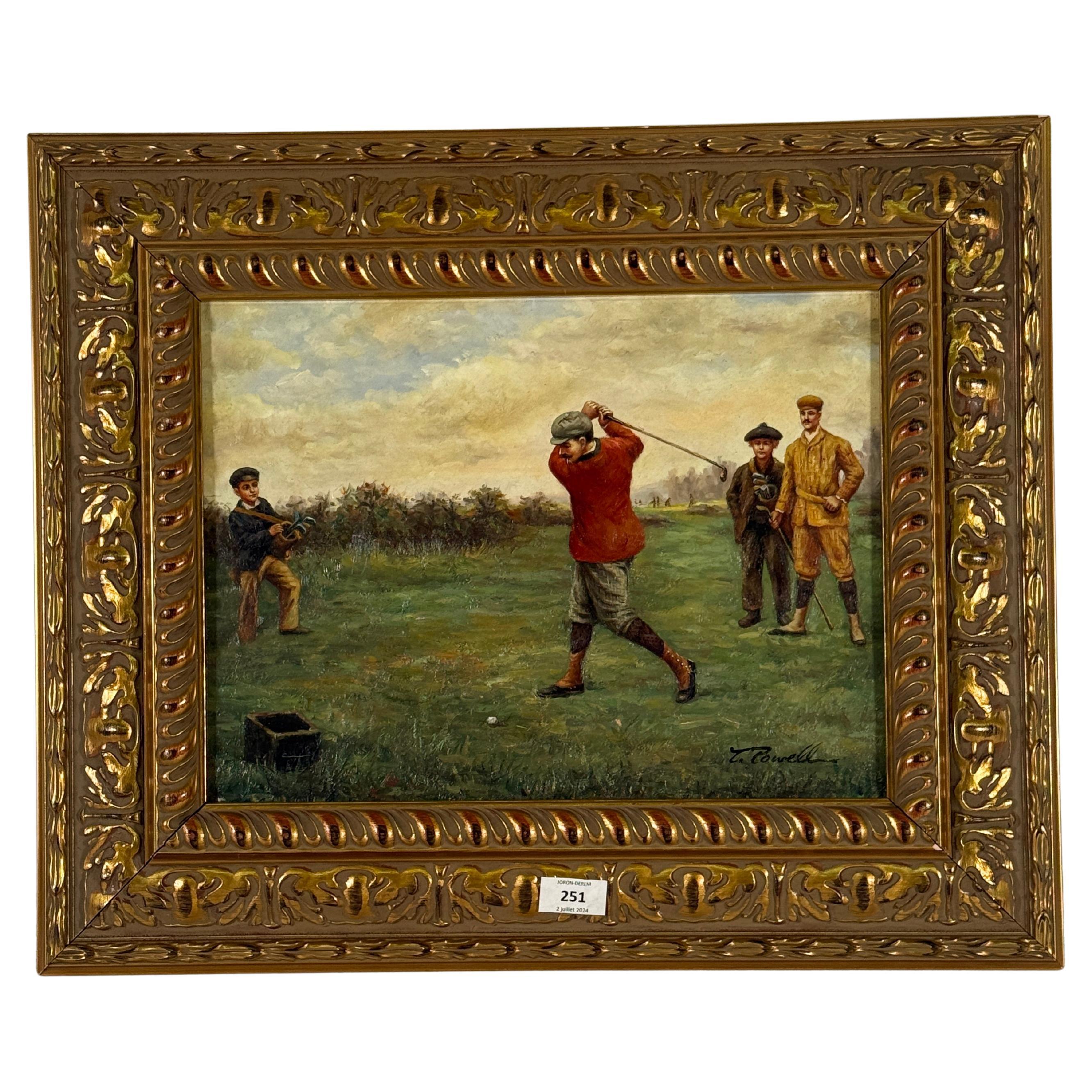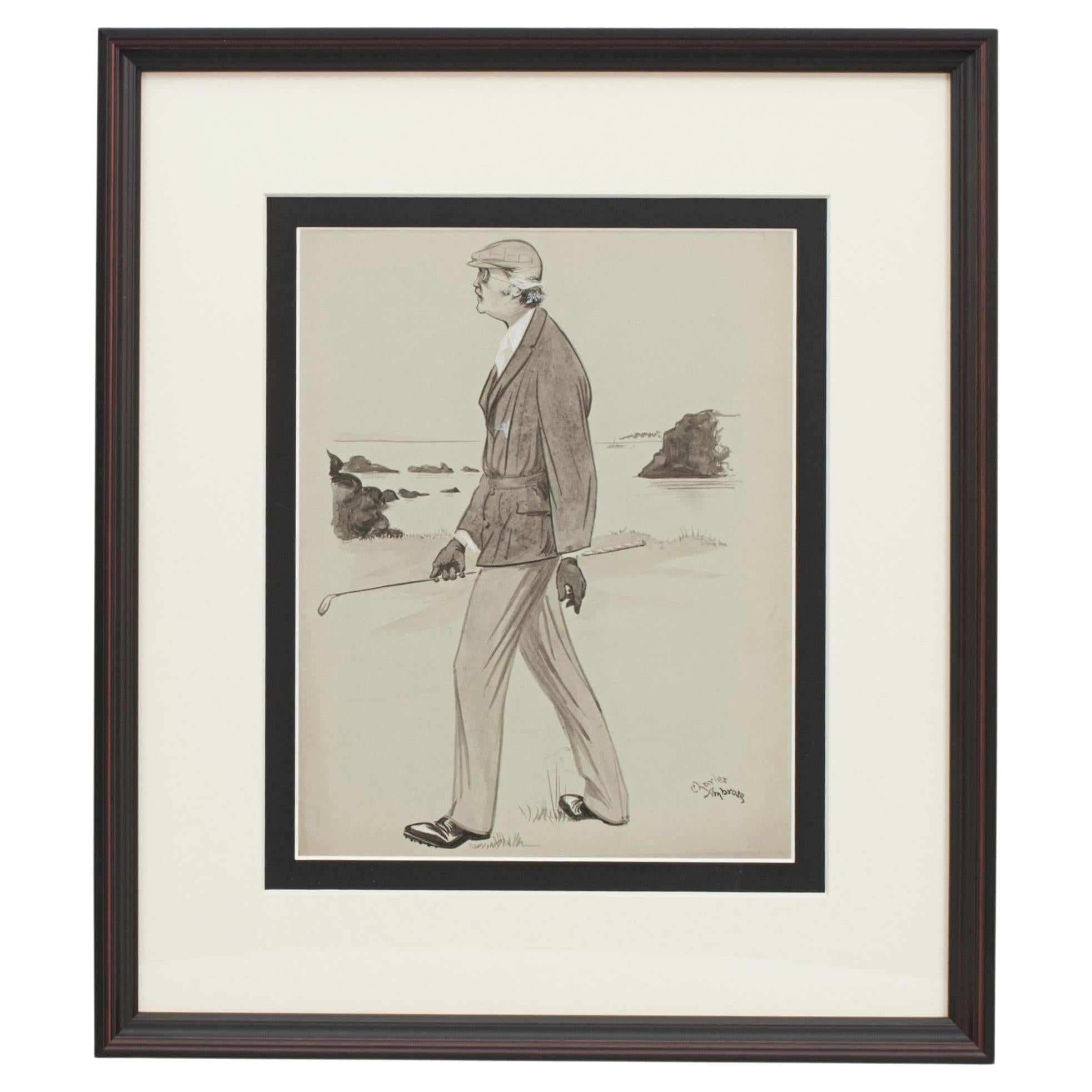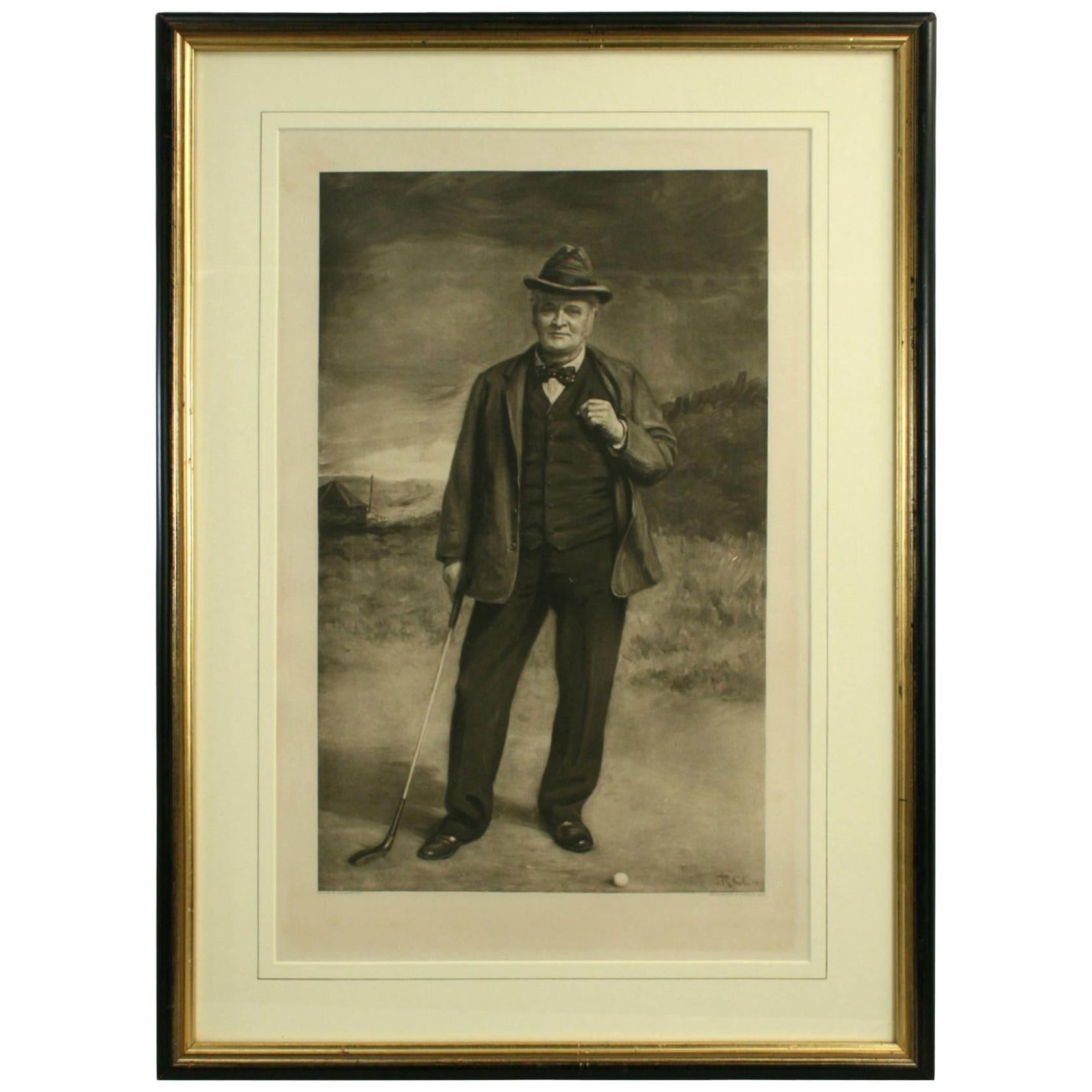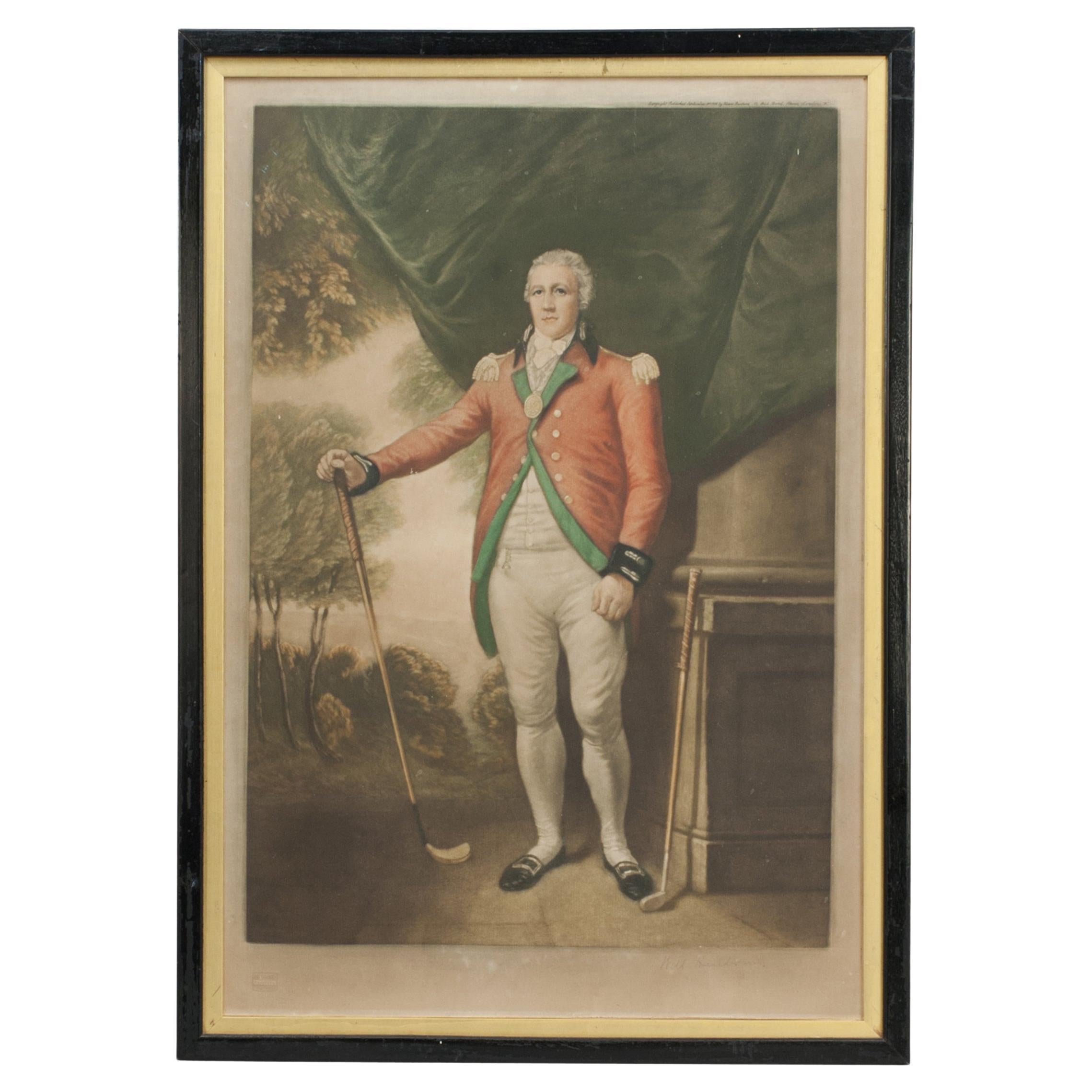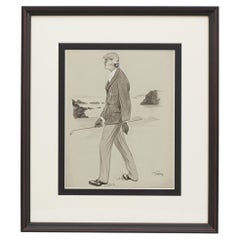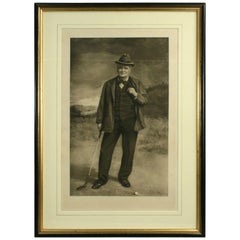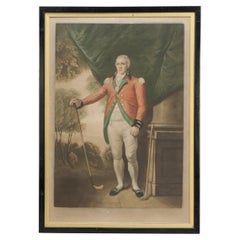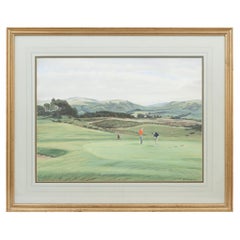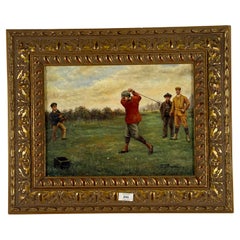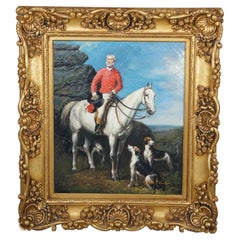Items Similar to Golf Oil Painting of Dr. William Laidlaw Purves by Hon. John Collier
Want more images or videos?
Request additional images or videos from the seller
1 of 12
Golf Oil Painting of Dr. William Laidlaw Purves by Hon. John Collier
$1,771.48
£1,300
€1,532.18
CA$2,438.07
A$2,717.48
CHF 1,425.77
MX$33,184.85
NOK 18,053.33
SEK 17,063.14
DKK 11,435.34
About the Item
Impressive modern Golf Portrait, William Laidlaw Purves.
Large oil on canvas of Dr. William Laidlaw Purves after the original oil painting by the Hon. John Collier (1850 - 1934), a prominent London artist. The painting is un-framed but is stretched and ready to hang, artist of this particular painting is unknown. The original painting now hangs at Royal St. George's, Sandwich. William Laidlaw Purves, oculist and obsessive golfer, was an Edinburgh born surgeon who worked in London, but remembered by most for his contributions to the golfing world. A very influential man, he was one of the key figures behind the spread of the game of golf in England towards the end of the 19th century. He won many important club trophies, the last being in 1914, aged 71 with a handicap of 3. He died at his home Hardwick Cottage, Wimbledon Common on 30th December 1917, and at the time he was a member of no fewer than 32 golf clubs.
As a student Purves had played golf at Bruntsfield Links in Edinburgh and by the time of his London appointment he was a member of both the Honorable Company of Edinburgh Golfers and the Royal and Ancient Golf Club of St Andrews. Upon his move to London in 1874 he joined the London Scottish and Wimbledon Golf Club. The two clubs shortly separated into two separate clubs, The London Scottish Golf Club and the Wimbledon Golf Club, but both continued to play on Wimbledon Common. In 1882 the Wimbledon became the Royal Wimbledon Golf Club and Purves became an active committee member, later being elected Captain. As the two clubs also shared the Common with the public play was restricted, so together with a fellow Scot and keen amateur golfer (Henry Lamb), Purves sort out a suitable place on the south coast of England for a seaside course for affluent Londoners.
Wanting to play on similar links to the ones they had both played on since childhood in the east coast of Scotland, they sort to emulate and rival St Andrews. In 1887 the site at Sandwich in Kent was where Purves designed and supervised the laying out of the course which he called St. George's, later becoming Royal St. George's Golf Club (it is said that the land was spied when viewed from the top of the church tower). In 1894 it was the first course outside Scotland to host the Open Championship. Purves was the first Captain of the club and can be seen in another famous oil painting, Members of Royal St. George's, 1892.
In 1888 he also designed the Littlestone golf course at New Romney, Kent.
Along with Henry Lamb and Issette Pearson, Purves introduced the golf handicap system into the UK, setting out the rules for the universal handicapping in 1898, evolved at Wimbledon where is was a member.
He became an active supporter of women's golf and instigated a meeting of fifteen ladies' golf clubs in the UK in 1893 which led to the formation of the Ladies' Golf Union (LGU) later that year.
- Creator:John Collier (Artist)
- Dimensions:Height: 47.05 in (119.5 cm)Width: 30.91 in (78.5 cm)Depth: 1.58 in (4 cm)
- Style:Sporting Art (In the Style Of)
- Materials and Techniques:
- Place of Origin:
- Period:
- Date of Manufacture:circa 2010
- Condition:Wear consistent with age and use. Very good.
- Seller Location:Oxfordshire, GB
- Reference Number:Seller: 284361stDibs: LU975724097982
About the Seller
5.0
Platinum Seller
Premium sellers with a 4.7+ rating and 24-hour response times
Established in 1977
1stDibs seller since 2013
788 sales on 1stDibs
Typical response time: 2 hours
Associations
LAPADA - The Association of Arts & Antiques Dealers
- ShippingRetrieving quote...Shipping from: Oxfordshire, United Kingdom
- Return Policy
Authenticity Guarantee
In the unlikely event there’s an issue with an item’s authenticity, contact us within 1 year for a full refund. DetailsMoney-Back Guarantee
If your item is not as described, is damaged in transit, or does not arrive, contact us within 7 days for a full refund. Details24-Hour Cancellation
You have a 24-hour grace period in which to reconsider your purchase, with no questions asked.Vetted Professional Sellers
Our world-class sellers must adhere to strict standards for service and quality, maintaining the integrity of our listings.Price-Match Guarantee
If you find that a seller listed the same item for a lower price elsewhere, we’ll match it.Trusted Global Delivery
Our best-in-class carrier network provides specialized shipping options worldwide, including custom delivery.More From This Seller
View AllGolf Painting by Charles Ambrose of Arthur Balfour, Former Prime Minister
Located in Oxfordshire, GB
Golf watercolour painting by Charles Ambrose Of British Politician Arthur Balfour.
Original watercolor en grisaille on board of Arthur Balfour in golfing attire, by Charles Ambrose....
Category
Vintage 1910s British Sporting Art Sports Equipment and Memorabilia
Materials
Paint
Antique Golf Portrait, Charlie Hunter of Prestwick, Photogravure
By Robert Cree Crawford
Located in Oxfordshire, GB
Charlie Hunter, golf club maker, Prestwick. Robert Cree Crawford,
A fine photogravure by Annan & Sons, after the painting by R.C. Crawford, of the famo...
Category
Antique Early 1900s English Sporting Art Sports Equipment and Memorabilia
Materials
Paper
Henry Callender, Golf Picture, Mezzotint
Located in Oxfordshire, GB
Golf Picture, Henry Callender ESQ.
Framed golf mezzotint of 'Henry Callender Esq' (Captain of the society of Golfers at Blackheath) after a painting by Lemuel Francis Abbott (1760 - 1803). The colourful print signed in pencil by the engraver Will Henderson...
Category
Early 20th Century British Sporting Art Paintings
Materials
Wood, Paper
Golf Painting Of The 10th Green - King's Course, Gleneagles - Arthur Weaver
By Arthur Weaver
Located in Oxfordshire, GB
Arthur Weaver Golf Print of Gleneagles, Canty Lye, 10th Green.
An original watercolour painting by Arthur Weaver. Entitled '10th Green, King's Course, Gleneagles', 1978. The picture ...
Category
Late 20th Century British Sporting Art Paintings
Materials
Paper
Vintage Golf Art, Humorous Golf Print, Putting for His Nose, Charles Crombie
Located in Oxfordshire, GB
A colorful humorous golf print after Charles Crombie entitled "Putting for his Nose". The picture is framed in an old dark brown oak frame with gold sl...
Category
Early 20th Century British Sporting Art Prints
Materials
Paper, Wood
Golf Painting by John Blair, Craigmillar Park G C
Located in Oxfordshire, GB
Craigmillar Park Golf Club Watercolour, John Blair.
An atmospheric original watercolour of Craigmillar Park Golf Links in Edinburgh by the Scottish artist John Blair (1849-1934). Craigmillar Castle from which the club derives its name from is clearly seen in the background and the painting is signed to the lower left corner. Craigmillar Castle was a haunt of Mary Queen of Scots, the world's first recorded lady golfer. How ironic then, that since the golf club's inception equality of the sexes was the rule at Craigmillar Park.
John Blair was a Scottish painter, predominantly of watercolour landscapes. Of humble beginnings in Berwickshire, he moved to Edinburgh to study and spent the rest of his life there. His paintings mainly reflect the landscapes around him, both of urban settings and also of the castles, sea and lochs of the Borders. As well as his original work, his paintings were viewed by a wide audience in the form of picture postcards, book endpapers and illustrations.
Taken from Craigmillar Park Golf Club website:-
Craigmillar Park Golf Club was constituted in 1895 and moved to its present location in 1907. It was extended to 18 holes (designed by James Braid) in 1927.
On 12th of January 1895 the Scotsman newspaper carried the following "birth" announcement :
"NEW GOLF COURSE IN THE SOUTH SIDE OF EDINBURGH. A nine-hole golf course is being formed at Craigmillar Park and is expected to be ready for play in February. A lease of the ground which extends from Crawfurd Road to Lady Road has been obtained from Captain Gordon Gilmour of Liberton and Craigmillar. The principal entrance will be from Crawfurd Road within three minutes' walk of the Craigmillar Park car terminus and Newington Suburban Station. The course is about a mile in length and has been laid out by Mr. Day of Musselburgh, who has given a very favourable report of the suitability of the ground for the purpose. Already about 150 ladies and gentlemen have been admitted as members of the club."
Many, perhaps most, of the new clubs created about the same time as Craigmillar Park were (and some continue) as male preserves. It is clear that from the outset equality of the sexes was the rule at Craigmillar Park, although it was not until 1914 that the subscriptions were equalised.
The course was situated in an area of land close to Newington Railway Station and the Newington Bus and Tram Terminus and was thus, easily accessible. In those days there was very little building development between the course and the iconic Craigmillar Castle from which the club derives its name. The castle was a haunt of Mary Queen of Scots, the world's first recorded lady golfer. How ironic then, that since the golf club's inception, ladies have had equal status with men and there was no gender barrier to any office. This was in an age when golf clubs were regarded as male preserves. In 1914, ladies started paying exactly the same subscription as their male counterparts and this has remained right up to the present day. When you consider that all women did not get the vote until 1928, Craigmillar Park Golf Club were indeed trendsetters!
Despite the club's early success, with 400 members and a waiting list, they were dealt a blow when their course at Newington was taken over for housing development. They decided, rather than to disband, to relocate the golf course to the eastern slopes of the Blackford Hill in 1907. Once again the close proximity of Blackford Railway Station and Bus Terminus were factors in their decision making. Another factor in choosing Blackford Hill was the potential for increasing the length of the 9 holes that had been played for in the course at Newington and possibly even converting the new course to 18 holes at some future date. This is in fact what happened and James Braid designed a splendid 18 hole course which officially opened in 1927. The new course was a real test of golf with no two holes being the same. The course boasts marvellous views over Edinburgh and Fife and down the coast to the Berwick Law, Bass Rock...
Category
Antique Early 1900s European Sporting Art Sports Equipment and Memorabilia
Materials
Paper
You May Also Like
Late 19th Century Antique English Oil Of A Golfer
Located in Scottsdale, AZ
Late 19th Century Antique English Oil Of A Golfer. Beautiful painting purchased in France. Age appropriate wear, see detailed photos or message us with questions.
Category
Antique Late 19th Century French Edwardian Paintings
Materials
Giltwood, Paint
Antique Illustration of a Golfer by Listed Illustrator for Vanity Fair
Located in Buffalo, NY
Antique illustration of a golfer getting out of a sand trap by well listed illustrator Leslie Saalburg whose work appeared in Vanity Fair and Esquire.
Category
1910s Realist Figurative Paintings
Materials
Gouache, Illustration Board
$871 Sale Price
56% Off
Portrait of a Gentleman - Scottish oil painting mid 20th century art
By William Oliphant Hutchinson
Located in London, GB
An original large Scottish portrait oil by noted Scottish artist William Oliphant Hutchinson. The work is a portrait of a gentleman, in a suit, with a rose in his lapel. This painting is a fine realist portrait. It dates to 1960 when he was at the height of his portrait career. This is a fine example of a mid 20th century Scottish portrait.
Signed and dated upper left.
Provenance. Scottish collection.
Condition. Oil on canvas, image size 36 inches by 28 inches and in good gallery condition.
Housed in a gallery frame, 43 inches by 35 inches framed and in good condition.
William Oliphant Hutchinson (1889-1970), was born at Kirkcaldy, Fife, Scotland, fifth child in the family of four sons and two daughters, of Henry William Hutchison of Kinloch, a Kirkcaldy businessman, and his wife, Sarah Hannah née Key. Educated at Kirkcaldy High School, Cargilfield School, Edinburgh, and later at Rugby School. As a boy he showed considerable promise as an artist and wanted to become a painter but his family were set on him entering business. In 1911, he spent a period in Paris, primarily to perfect his French where he also took this opportunity to study at the Atelier Delecluse, striking up a lifelong friendship with Scottish artist, [Sir] James Gunn (1893-1964). On his return to Scotland he entered the family timber business but, with his father's permission, entered Edinburgh College of Art, having a portrait of his younger sister Nancy exhibited at the Royal Scottish Academy in 1911. Whilst studying in Edinburgh he came under the influence of watercolourist Edward Arthur Walton...
Category
20th Century Realist Portrait Paintings
Materials
Oil
Portrait Painting Charles Trelawny Master of Dartmoor Hunt After Francis Grant
By Francis Grant
Located in Dayton, OH
Portrait of Charles Trelawny, Esq., Master of the Dartmoor Hunt, on his favourite hunter Grimaldi, with the hounds Conqueror, Lounger and Windermere). After Francis Grant.
Dimens...
Category
Late 20th Century Paintings
Materials
Canvas, Paint
$640 Sale Price
20% Off
Major R Sloane-Stanley by George Hillyard Swinstead, 1916
Located in Lymington, Hampshire
This three-quarter length oil on canvas portrait shows Major Sloane-Stanley in a landscape by the sea. He is smoking a cigar and wearing a Royal Yacht Squadron cap. Signed lower left ‘G Hillyard Swinstead 1916’ the reverse inscribed in pencil ‘Major R Sloane-Stanley, Hants Yeomanry 1916’ . English.
Capt. thence Lt Col Ronald F A Sloane-Stanley of the Hampshire Regiment (1867 – 1948) served as Deputy Lord Lieutenant of Hampshire. As a close friend of Edward VII, he reputedly procured two billiard tables from Osborne House (East Cowes, Isle of Wight) for Lee- on-the-Solent Yacht Club, of which he was the founding Commodore in 1907. He was also a member of the Royal Yacht Squadron from 1907 until his death, owning seven yachts during that period. He served on the Yachting Committee between 1935 and 1946.
Despite Sloane-Stanley's long history of involvement with yachting, there is one yacht with which his family is associated that overshadows all of his other great achievements in the sport. The Formosa, built for his father Francis Sloane-Stanley in 1877, was acclaimed as a masterpiece of maritime design before she was even launched. In a rhapsodic article published on the 22nd of February 1879, The Field newspaper describes her as “the most beautiful cutter yacht ever built”.
In addition to her fine attributes as a racing vessel, the article also mentions the luxurious way that she was decorated inside, personally supervised and designed by Mrs Sloane-Stanley-our sitter's mother.
The Formosa, pictured above, became so famous that shortly after this article was written Francis Sloane-Stanley sold her to his friend the Prince of Wales (later Edward VII). There are several images of the Formosa in the Royal Collection, all dating from 1880. The Prince raced her on multiple occasions and her victories included the Queen's Cup on the 3rd of August 1880. By 1881, however, the Prince had sold her to a “Mr Bischoffsheim” as reported in the as reported in the Portsmouth Evening News on the 23rd of July of that year.
Although Ronald Sloane-Stanley would have been 12 at the time the Formosa was raced by his father it is highly likely that seeing this beautiful cutter, and the success that it brought to his family, would have inspired Ronald's own yachting career.
Additionally, as the same article in The Field makes clear, the Sloane-Stanley family were related in some way to Thomas Assheton-Smith, a founder member of the Yacht Club (later the Royal Yacht Squadron). The family is therefore a highly renowned one in yachting circles and we were lucky enough to be able to offer a silver gilt trophy won by Assheton Smith at the Regatta in 1828 in one of our previous catalogues. This portrait is a very exciting piece of yachting memorabilia as well as a superb work of art in its own right.
The Artist
George Hillyard Swinstead...
Category
Vintage 1910s English Paintings
Materials
Paint
Portrait of Mr R H Sinclair - Scottish 1914 art male portrait oil painting
By David Cowan Dobson
Located in London, GB
This impressive large portrait realist oil painting is by noted Scottish artist David Cowan Dobson. One of a pair, the sitter is Mr R H Sinclair and dates to 1914. He is beautifully ...
Category
1910s Realist Portrait Paintings
Materials
Oil
